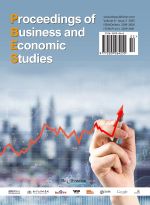Study on the Impact of Strong Provincial Capitals on Regional Innovation Efficiency
Abstract
Strong provincial capital is an important initiative for underdeveloped regions to realize rapid regional economic development through leading by point, which is related to the overall situation of China’s economic high-quality development. This paper theoretically analyzes the internal mechanism of strong provincial capitals affecting regional innovation efficiency. The study finds that the policy of strong provincial capitals promotes the formation of the resource aggregation effect in the capital cities, attracts talents, technologies, policies, and capital and other factors, improves the efficiency and quality of innovation, and drives the development of neighboring regions. However, over-implementation of the policy will lead to a large number of “big enterprises,” which will lead to rent-seeking, waste of resources, crowding out of government subsidies and congestion effects, inhibit innovation, and lead to the loss of innovation factors in peripheral cities, dragging down the innovation level of the whole province. Therefore, the relationship between strong provincial capitals and innovation is an inverted “U” shape, and this study is of great significance for understanding the double-edged sword effect of strong provincial capitals and formulating scientific regional innovation policies.
References
Ju X, Lu D, Yu Y, 2013, Financing Constraints, Working Capital Management and Corporate Innovation Sustainability. Economic Research, 48(01): 4–16.
Zhang X, Liu B, Wang T, et al., 2017, Credit Rent-seeking, Financing Constraints and Corporate Innovation. Economic Research, 52(05): 161–174.
Wan J, Zhou Q, Xiao Y, 2020, Digital Finance, Financing Constraints and Corporate Innovation. Economic Review, (01): 71–83.
Kleer R, 2010, Government R&D Subsidies as a Signal for Private Investors. Research Policy, 39(10): 1361–1374.
Zhang W, Peng J, 2001, Empirical Analysis of Incentive Mechanism for Knowledge-based Employees in Chinese Enterprises. Research Management, (06): 90–96 + 62.
Marshall A, 1890, Some Aspects of Competition: The Address of the President of Section F — Economic Science and Statistics — of the British Association, at the Sixtiet Meeting, held at Leeds, in September, 1890. Journal of the Royal Statistical Society, 53(4): 612–643.
Zhao K, Hou Q, Li W, 2021, Spillover Effects of Economic Development in Provincial Capital Cities — An Analysis based on Industrial Enterprise Data. Economic Research, 56(03): 150–166.
Wu C, Meng X, 2022, Siphoning or Overflow? — An Analysis of the Economic Growth Pole Effect of the “Strong Provincial Capital” Strategy. Journal of Anhui University (Philosophy and Social Science Edition), 46(01): 124–136.
Fu T, Zhang T, 2022, Whether Urban Boundary Expansion Can Form a New Driving Force for Economic Growth — Taking the Expansion of Some Provincial Capital Cities as an Example. Economic Science, (04): 50–63.
Wang T, Wang Y, 2019, Strong Provincial Capital Strategy and Intra-regional Urban-rural Income Disparity-evidence From a Provincial Panel in China. Journal of Fuzhou University (Philosophy and Social Science Edition), 33(05): 14–20.
Zhang H, Ding R, 2020, Realistic Foundation of Implementing the Strategy of “Strong Provincial Capital” and its Possible Orientation. Reform, (08): 147–158.
Yang B, Liu S, Chang X, 2023, Research on the Innovation Effect of “Strong Provincial Capital” Strategy. Research on Quantitative and Technical Economics, 40(03): 168–188.
Zhuang Y, Yang S, 2021, The Impact of “Strong Provincial Capital Strategy on Regional Innovation Development — Radiation or Siphoning? China Soft Science, (08): 86–94.
Mao Q, Xu J, 2015, The Impact of Government Subsidies on New Product Innovation of Enterprises — Based on the Perspective of “Moderate Range” of Subsidy Intensity. China Industrial Economy, (06): 94–107.
Yuan J, Hou Q, Cheng C, 2015, The Curse Effect of Corporate Political Resources An Examination based on Political Association and Corporate Technological Innovation. Management World, (01): 139–155.
Bai J, Chen Y, Li J, 2008, Research on Innovation Synergy within Enterprises and Its Influencing Elements. Science Research, (02): 409–413 + 434.
Wu Y, 2007, Firm Size, Market Power and Innovation: A Literature Review. Economic Research, (05): 125–138.
Kong D, Xu M, Kong G, 2017, Internal Pay Gap and Innovation in Enterprises. Economic Research, 52(10): 144–157.

